This new project aims to co-produce a new open ‘access’ digital resource that facilitates engagement with, and use of, public archival material online. Daniel H. Mutibwa and Fiona Philip help join the dots.
About the authors:
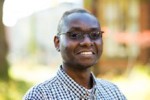 Daniel H. Mutibwa is Research Fellow in the School of Media and Communication (SMC), University of Leeds. He has researched and taught in SMC since 2008 on a wide number of topics including emerging innovative business models and growth aspirations of creative SMEs/microbusinesses in the media and creative/cultural industries, the relationship between creative/cultural industries and the physical environment, co-production research in a range of realms and third sector research, particularly social enterprise and social innovation.
Daniel H. Mutibwa is Research Fellow in the School of Media and Communication (SMC), University of Leeds. He has researched and taught in SMC since 2008 on a wide number of topics including emerging innovative business models and growth aspirations of creative SMEs/microbusinesses in the media and creative/cultural industries, the relationship between creative/cultural industries and the physical environment, co-production research in a range of realms and third sector research, particularly social enterprise and social innovation.
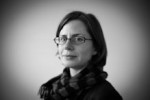 Fiona Philip is Research Fellow on the Pararchive Project, and is based at the School of Media and Communication, University of Leeds. Having also worked as the RA on the ECRC-funded Communicating Copyright project, Fiona is interested in the copyright-related dilemmas and opportunities of Pararchive. Alongside issues of ownership and participation in the digital age, her research also considers the interwar literary and cinematic output of the neglected British modernist impresario and writer, Bryher, and the avant-garde film group, POOL. She is co-editor of the 2012 Special Issue: Austere Cultures/ Cultures of Austerity, Journal of European Popular Culture 3(1), and is currently collaborating (with Lee Edwards) on the Communicating Feminism project with Rape Crisis England & Wales.
Fiona Philip is Research Fellow on the Pararchive Project, and is based at the School of Media and Communication, University of Leeds. Having also worked as the RA on the ECRC-funded Communicating Copyright project, Fiona is interested in the copyright-related dilemmas and opportunities of Pararchive. Alongside issues of ownership and participation in the digital age, her research also considers the interwar literary and cinematic output of the neglected British modernist impresario and writer, Bryher, and the avant-garde film group, POOL. She is co-editor of the 2012 Special Issue: Austere Cultures/ Cultures of Austerity, Journal of European Popular Culture 3(1), and is currently collaborating (with Lee Edwards) on the Communicating Feminism project with Rape Crisis England & Wales.
Context of the project Funded under the AHRC Digital Transformations in Community Research Co-Production in the Arts and Humanities and led by Simon Popple (University of Leeds), Pararchive (http://pararchive.com/) aims to co-produce a new open ‘access’ digital resource that facilitates engagement with and use of public archival material online. It will allow anyone to search and collect online sources and to combine them with their own media (film, photographs and other ephemera) in order to tell their own stories, make new archives, be creative, start new projects and do their own research. Pararchive will, for example, allow communities to research and document their histories via the creative linking of their own digital content with archival material from Pararchive’s institutional partners - the BBC and the Science Museum Group.
Pararchive started in October 2013 and is divided into four phases. The first identified user needs, research story interests and functionality of the digital resource through running technology lab workshops with four distinct community groups. In Phase Two an early interactive prototype of the resource was constructed based on the specifications developed in Phase One while in the third and ongoing phase, the beta version of the digital resource and other tools will be tested by our four community groups for suitability. A process of evaluating the experiences of our community group members, institutional partners and the technology team will follow in Phase Four, culminating in the production and launch of the open ‘access’ digital resource at our Community Showcase and Conference entitled Connecting Communities: Storytelling and the Digital Archive (http://bit.ly/1s4CNO3) on Friday 27 and Saturday 28 March 2015 at the University of Leeds.
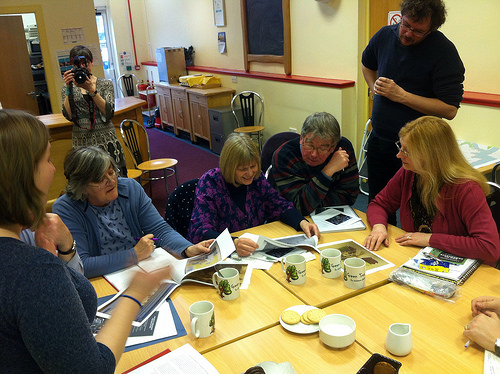
Identifying Research Story Interests in a Technology Lab Workshop, Bute
Background of the project The idea for Pararchive comes from two previous projects (The Open Archive Project and Fusion) that – in partnership with the BBC – investigated how people can connect with and make use of digital archival resources. The two projects explored how communities might take ownership of cultural and historical materials in which they are represented, and how they could use archival sources to give voice to their own stories and construct their own histories. The research resulted in the joint creation of a series of films entitled Strike Stories. A subsequent Creative Technology Lab in 2012 (http://bit.ly/1u0z6Ft) built upon this research by exploring how these community stories and histories as well as aspirations and ideas could be turned into a real resource open to anyone. An online resource named Pararchive was modelled and funding for it secured. Previous research has shown the need to work collaboratively to co-create this new resource.
Methodology Currently, we are working together with a technology partner (www.carbonimagineering.com/) and four community groups (Brandanii Archaeology and Heritage (Bute) (www.discoverbutearchaeology.co.uk/), Ceramic City Stories (Stoke-on-Trent) (http://ceramiccitystories.org/about), Bokeh_Yeah! (www.facebook.com/BokehYeah), and Arduino MCR (Manchester) (www.facebook.com/ArduinoMCR) through technology lab workshops which take place every four to six weeks on average. Here, community group members draw on, add to and curate resources around shared cultural, historical and thematic interests and affinities drawn from a wider number of platforms and institutional sites to tell their stories. Initial workshops were designed in such a way that conversations and activities happened ‘offline’ in order to solely focus on members’ research story interests and to identify any possible connections between these without the distraction from digital gadgets. Some of the emergent and recurring themes revolve around archaeology, farming, conservation of natural resources and landscapes, wildlife, urban greening, history of family work and the creative industries, activism, young people and pottery, reminiscence and memory, digital and music heritage, and the exploration and digitisation of archives.
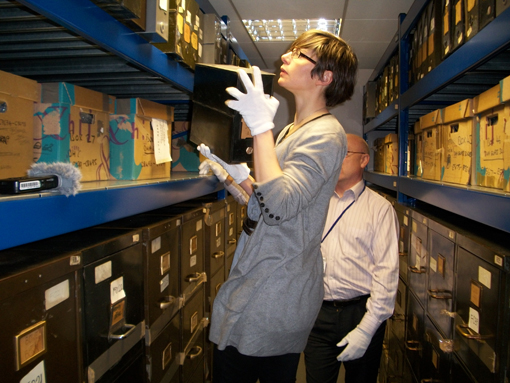
Fiona Philip behind the Scenes at the National Media Museum, Bradford
Members utilised workshops to ask questions. The two most frequently asked questions were: how did the other community groups become involved with Pararchive and how real was the possibility of obtaining access to institutional archives? Members learnt that the other community groups on the project came on board as a result of two aspects: existing and new links made by Simon Popple and their distinctive research interests. Regarding access to the archives of our institutional partners, we explained that our partners were keen to open up the cultural assets in their archives to community groups that can use their knowledge and expertise to add value to such assets in order to ensure their on-going relevance, and that Pararchive was an experiment towards achieving this goal. We pointed out that Pararchive was not just about searching archives and repurposing archival material to tell stories, but that it was also about feeding back on members’ experiences, something that would contribute to the creation of knowledge beneficial to others. Indeed, the starting point for Pararchive is the realisation of the difficulty of searching institutional archives, often exacerbated by interfaces that are too complex to work with, thereby putting a barrier between archives and users.
At the end of each workshop we reflected on the conversations and activities undertaken, looked for recurrent patterns and connections in the stories told, assessed the sources from which artefacts had been drawn, discussed and planned activities for next workshops, monitored the research progress of each individual member, and offered support and encouragement where needed. Recent workshops have been structured around story-building exercises in a ‘paper prototyping’ process. The idea is that a story or an idea is broken into the smallest atomic element possible. Such elements can be in the form of a block or an event, information (metadata about dates, places, people), artefacts (which enrich/support the story e.g., photographs, audio-visual content) and connectors (that link the blocks/events together). It is from this input that the early interactive prototype of the digital resource has been developed and is currently being tested by members. We plan to invite up to six new community groups to trial the resource at the end of 2014 in order to ensure that the resource we create will be genuinely open, easy to navigate and intuitive to use for as many people as possible.
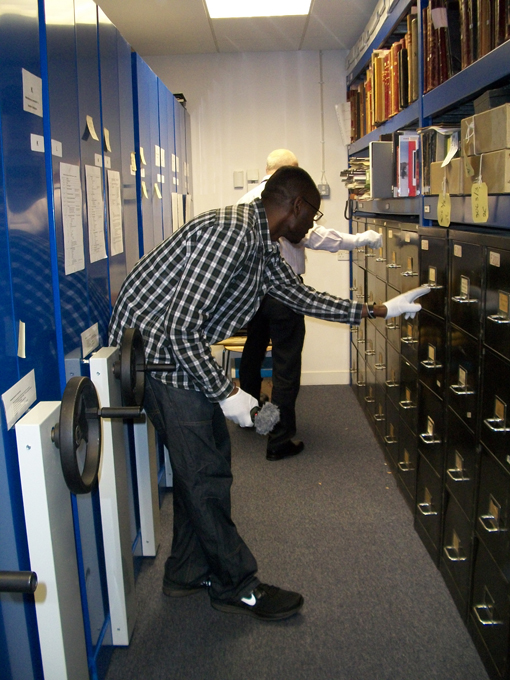
Daniel H. Mutibwa behind the Scenes at the National Media Museum, Bradford
Projected Outcomes In a broader context, Pararchive addresses crucial issues related to the idea of open digital space, community use of cultural assets, self-representation and the potential not only to engage new online communities that would not traditionally engage with cultural institutions, but also to inform how the latter can facilitate public interaction with their assets more effectively. Moreover, we are identifying, gathering and providing useful archival content links and developing toolkits (e.g., community guidelines for archiving, ‘DIY’ object digitisation and handling copyright) to facilitate further community-led research. More importantly, we plan to construct the digital resource in two formats; one a centrally hosted open version free to all users, and the other, a takeaway open-source tool that community, education and public groups can use for specific research purposes and self-host. Not only do we hope that Pararchive will demonstrate the value of collaborative working around shared research agendas, practices and knowledge exchange partnerships, but we want Pararchive to deliver a lasting legacy in the form of a repository of both personal and institutional resources researched, co-designed and evaluated by its users while simultaneously building on such resources to explore other possible strands of research.
Daniel H. Mutibwa / Fiona Philip Web: http://pararchive.com/ Twitter: @Pararchive